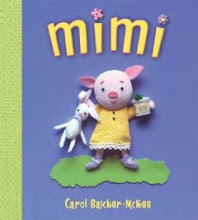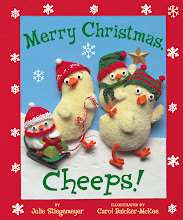 I've agreed to speak at the April 1st CPSIA Fly-In, Rally, and Congressional Briefing on vintage books. I'm slightly terrified; it feels like a gigantic responsibility, and most of my speaking experience for the last ten years is to groups of school kids who like my fart jokes and curly bug demonstrations. I think I have to be a little more serious to speak to congressmen.
I've agreed to speak at the April 1st CPSIA Fly-In, Rally, and Congressional Briefing on vintage books. I'm slightly terrified; it feels like a gigantic responsibility, and most of my speaking experience for the last ten years is to groups of school kids who like my fart jokes and curly bug demonstrations. I think I have to be a little more serious to speak to congressmen.Outline: Speech on CPSIA and Books
Amend the CPSIA Rally, April 1, 2009
I. Thanks and intro self Author/illustrator and lifelong advocate for children (doctorate in clinical child psychology, early childhood educator, classroom and literacy volunteer, parent, etc. Well aware of the real risks of lead poisoning in kids.) Quick description of how books handled under CPSIA (exemptions for books for kids up to 12 printed after 1985 for possible lead in ink; also for collectible books that because of rarity and value would not be given to children.) Not enough - urging exemption for all books, including vintage ones.
II. Vintage books are safe. Speaking as a scientist with experience and expertise in interpreting research findings.
A. No known cases EVER of lead poisoning from books (of 44 rare sources of lead poisoning in children cataloged by CDC, none is from a book – only print-related case was an infant who had elevated levels after parents burned logs made from old newspapers – people don’t burn children’s book logs.) No mention ever, anywhere of lead in books even contributing to elevated lead levels.
B. Statement by CDC (“on a 1-10 scale, books are a 0.5 risk”)
C. If a something is a significant source of a toxin, then people with a high rate of exposure to the source should suffer more harm than those with a low rate of exposure. Instead, we find just the reverse with books, even when we look only at studies conducted prior to 1985 (when lead in books no longer an issue). Children with more books in the home, who spent more time engaging in leisure reading, or who were read to more by their parents fare better on the outcome measures associated with lead poisoning – like IQ, school achievement, rates of learning disorders and ADHD, frequency and severity of antisocial and aggressive behavior. (Caveat – this is all correlational evidence, just like the studies linking blood lead levels and poor outcomes – neither proves clear, causative pathways.)
D. Lead is found only in some old books (but no way to tell which ones without testing) Even the worst offending books are borderline cases; highest levels being found by CPSC’s digestive testing are around 300ppm (below current allowed levels, around the level that goes into effect in August). No feasible way to detect which books are safe and which aren’t – can’t use XRF testing for books, where ink is part of substrate, and since used booksellers’ inventory tends to be OOAK, digestive testing is impossible as well as obscenely expensive.
E. Book ink poses virtually no threat under normal use and abuse by a child
i. Book ink soaks into paper, does not rub off on hands
ii. Research on absorption of lead from ink – saliva can’t leach
iii. Bibliophagia (eating books) rare at any age.
1. Normal for babies and toddlers to mouth board books (usually just edges), but studies show putting books in mouth becomes unusual past 18-24 months. Law covers books for kids up to age 12, 10 years past age when mouthing occurs.
2. Actually eating the book is exceedingly rare – usually sign of pica, a medical condition in which people compulsively eat non-nutritive substances (and thus not under the umbrella of “normal use and abuse.”(and only found 2 cases in which young children were said to have eaten a book, along with other substances that posed much greater risk of lead poisoning or other health problems – both kids were later diagnosed with pica and treated for underlying medical conditions.)
F. Emerging evidence that exposure to books may help to both prevent and treat harmful effects of lead toxicity.
i. Evidence from human observational studies that mentally stimulating environment is protective against lead’s ill effects. [Bellinger (major lead researcher from Harvard); CDC recommendations]
ii. Evidence from animal studies also supports those conclusions (rat studies)
iii. Books are easy, inexpensive way to provide enriching environment, plus increase parental engagement with child, creating a virtuous spiral of better environment for child. Success of early literacy book distribution programs.
G. Despite safety that is clear even to public health officials, equally clear that vintage books as a class nonetheless do not pass muster under the excessively strict guidelines of the CPSIA – total lead content in vintage books sometimes exceeds 300 ppm, and more will exceed 100 ppm if/when that goes into effect in August, 2011; there’s a general lack of peer-reviewed, scientific evidence (don’t study what’s not a problem) and none likely to be available any time soon; what little evidence there is prevents assertion that there’d be no absorption of any lead ever from an old book – just that the risk is insignificant.
i. Bottom line: if a parent, teacher or librarian asked my professional advice about removing old books, I’d tell them not to, and if they’d be unable to replace those books, the answer would be an emphatic NO – the risks from having few or no books greatly outweighs the miniscule risk of lead exposure.
ii. I’d still give my kids vintage books. Talked to many parents; all would continue to allow their kids access to older books.
III. Why Should Anyone Care?
A. Aren’t old books worthless? (That's what CPSC thinks)
i. No one uses books more than 20 years old - they’re worn out and the content is obsolete, right?
ii. The exemption for collectibles covers the special old books, like the first edition Winnie the Poohs, so nothing more is needed, right?
iii. Publishers could just reprint the old books if someone wanted them, right?
B. WRONG! Loss of number of books available to kids – hard to say for certain, but likely hundreds of millions of old books currently in use by kids.
i. Old children’s books have remarkable staying power, both in content and physically
ii. The number of books at risk also must include books that were printed post 1985 but which lack print dates – a common practice in kids’ books. Likely affects millions or even billions more volumes.
iii. Contrary to CPSC assertions, discarding old books would have devasting impacts on library collections – estimates vary, but even well to do libraries estimate as much as 1/3 of their collections would be lost. Small, low income libraries could be even worse.
iv. Equally terrible impacts on schools and childcare facilities, also contrary to CPSC assertions. Old books in libraries, classroom libraries (often assembled out of the teacher’s own pocket), sets of classroom novels used only a few times a year.
v. Also hurts home libraries. Number of books in the home one of the best predictors of child’s success in school (after maternal education). Vintage books often significantly cheaper and better quality than even more recent used reprints (because of law taxing warehouse inventory).
vi. The one category with a low survival rate is books for the youngest kids – the ones at greatest risk for ingesting books and for lead poisoning. Thus the books that pose the greatest risk – but still small – are not a significant problem.
C. Loss of diversity in books available to kids – as bad as the loss of number
i. New books don’t make old books worthless anymore than second child makes first one obsolete. Compare also with suggestion that we discard all paintings done before 1985 because they also contained lead – we can just get by with new paintings, copies of old masters, cheap reproductions. Doesn’t sit right, does it? Same emotional response to this law by people who know and love children’s literature.
ii. Most old books out of print in any form – loss is not just of volumes, but of actual titles, content, values, historic style, etc.
iii. Most unlikely to be republished (variety of reasons)
iv. Differences between new and old books, even when reprints available (paperbacks vs. hardcovers, quality of paper and printing, loss of special features like endpapers, jackets, re-illustration, changes in text to reflect current values).
v. Certain categories more affected than others (like poetry, other non-fiction, anthologies and collections)
vi. This problem reflexively feels like censorship to most people, even though that’s not probably not what was intended. (Not helped by 1984 cutoff date.) At a minimum creates de facto censorship.
D. Economic Impact 1 - Threat to businesses, individuals that sell older books
i. Huge impact on used booksellers large and small – Quotes from Half Price Books, Jacobsen books, Deputy Headmistress (others?)
ii. Hard to judge overall impact in dollars, but likely substantial, especially as it’s not uncommon for a book to be resold more than once.
iii. Good business for tough economic times – internet makes it easier than ever to make money through resale. Prices are low enough that the product is affordable to families suffering through hard times. Amusement for child with hours of use and re-use, educational, quiet, etc.
iv. Common and profitable items at yard sales – right now many families need even the small change that these kinds of sales produce.
E. Economic Impact 2: Hurts charities that raise revenue through book sales (like libraries, Goodwill, literacy programs)
i. Literacy programs also redistribute used books to homes, schools, child care centers, after school programs, waiting rooms
ii. Also hurt charitable recipients overseas – we ship used textbooks and trade books to schools in 3rd world countries to stock schools. Not allowed under CPSIA
F. Groups especially hurt by loss of old books
i. Chronically needy, families hurting in recession – increased costs of books for kids; harm to institutions in low-income areas doubles impact.
ii. Home schoolers – low cost way to obtain necessary teaching materials
iii. Gifted children – older books tended to have more innocent themes, while having more difficult vocabularies and longer, more complex texts (c.f., Make Way for Ducklings with a modern duck picture book for same age).
G. Loss of history of children’s literature
i. Children’s books not just used by kids, but will be lost to adults too. Impact on social scientists, historians, children’s lit scholars, contemporary authors and illustrators (and thus harm to quality of books going forward), book artists.
ii. Exemption for collectibles not sufficient to protect books from extinction or unavailability – most old books sell for less than new books, making it difficult to argue they’re too valuable to give to children. Also, dividing line is in the eye of the beholder, making selling collectibles an uncertain business.
iii. Will increase rarity and drive up prices, putting old books out of reach of all but the wealthiest individuals and institutions.
iv. Sharing childhood books is especially powerful spur to connecting generations, interesting reluctant parents in reading to their kids
In sum: Harm likely to be caused to books and kids under CPSIA greatly outweighs any possible small benefit in terms of reduced lead exposure.
IV. Action I’d like to see
A. 1st choice: repeal act and start over. Too flawed, piecework amendments will make an already too-complex law even more complicated and increase violations and difficulty of enforcing it.
B. Otherwise, amend law to make it more reasonable – and thus more effective.
i. Exempt all books, except those with high risk components (like baby bath books). (Other categories of books with unnecessary burdens, like most novelty books, stapled books, books aimed at older kids with risky components)
ii. Limit age range to under 3
iii. Make standard for getting exemptions more reasonable – give CPSC more discretion (e.g., reliance on expert advice in absence of peer reviewed scientific evidence), ability to balance risks and benefits
iv. Get rid of retroactivity of law – if problem not serious enough to recall/recommend discarding ALL old kids’ products
v. Un-deputize states’ attorneys general, or require them to follow guidelines set by CPSC.
vi. Make penalties less extreme for all but the worst offenders.
vii. Say what you mean, and mean what you say – if CPSC doesn’t intend to go after used booksellers or people holding yard sales, make it law, not Russian roulette
viii. Let parents make their own choices for their own kids – allow warning labels or an educational campaign instead of banning books for all.
ix. Concentrate resources instead where most fruitful – will increase compliance, ease enforcement, gain buy-in by folks who care about kids, like those here today.









 These books above are all well used cheap paperbacks, all printed in the 1970s or earlier. The pages have yellowed a bit and a couple of the most heavily read have mangled spines (like the copy of
These books above are all well used cheap paperbacks, all printed in the 1970s or earlier. The pages have yellowed a bit and a couple of the most heavily read have mangled spines (like the copy of 






 I love how she handled the challenge of facing pages that couldn't really bleed together, given the printing limitations at the time.
I love how she handled the challenge of facing pages that couldn't really bleed together, given the printing limitations at the time.





 First, there are as many reasons to prefer the stapled bindings as to dislike them. Glued bindings just don't hold well unless there are lots of pages, and a standard picture book has only 32 pages. You may have had the experience with a perfect-bound book of pages coming loose (like the book above - a copy of Alfie's Feet by Shirley Hughes, one of my favorite children's book author-illustrators) or even coming out all together and getting lost. The stapled bindings which fasten folded pages rather than individual sheets almost never lose pages unless they're ripped. In addition, the stapled bindings generally lay flat and stay opened, an advantage for little guys and kids just learning to read, who may find juggling holding a book open and steady to be just one task too many on top of the challenging job of deciphering the words.
First, there are as many reasons to prefer the stapled bindings as to dislike them. Glued bindings just don't hold well unless there are lots of pages, and a standard picture book has only 32 pages. You may have had the experience with a perfect-bound book of pages coming loose (like the book above - a copy of Alfie's Feet by Shirley Hughes, one of my favorite children's book author-illustrators) or even coming out all together and getting lost. The stapled bindings which fasten folded pages rather than individual sheets almost never lose pages unless they're ripped. In addition, the stapled bindings generally lay flat and stay opened, an advantage for little guys and kids just learning to read, who may find juggling holding a book open and steady to be just one task too many on top of the challenging job of deciphering the words.  I'm going to blog about this vintage book in a separate post, so check back if you want to learn more about the notable book about the curious little Scottie .
I'm going to blog about this vintage book in a separate post, so check back if you want to learn more about the notable book about the curious little Scottie .


















